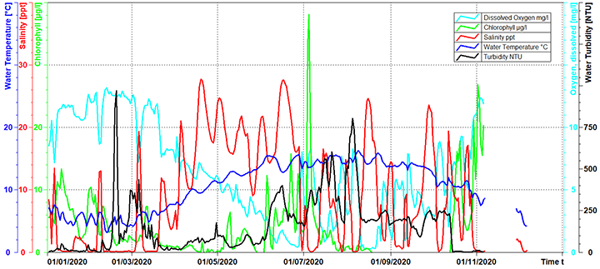Inner Clyde Estuary monitoring buoy, Firth of Clyde
Continuous water quality monitoring equipment was deployed in the inner Clyde estuary adjacent to Govan in 2011. Low dissolved oxygen concentrations are known to occur in the inner Clyde estuary at this location as a result of the decomposition of organic wastes from discharges and urban run off.
Limited mixing between fresh water and more dense saltwater leads to large differences between the salinity of surface and bottom waters in the Clyde estuary as the less dense fresh water sits on top of the more dense salt water. This can lead to large differences in dissolved oxygen between surface and bottom waters as oxygen removed from the bottom waters by decomposition of organic matter in the sediments is not replaced by oxygen supplied by the river and transferred into the surface waters from the air.
Inner Clyde Estuary monitoring buoy factsheet
We have developed a buoy factsheet that provides information about our water monitoring in the Inner Clyde Estuary.
Current observations
Data is collected at 15 minute intervals and the data are displayed as daily averages.
Surface data

Bottom data

Data requests
If you require any further information regarding our monitoring buoys please contact us.
Disclaimer
The monitoring buoy data is gathered by SEPA to help it fulfil its statutory duties. We publish it online because we recognise that this information may also be useful for others, but we cannot guarantee its currency or availability. Use of the data is subject to our standard terms and conditions of reuse. The majority of our buoys do not have remote telemetry and so data availability is subject to monthly downloads when the buoys undergo maintenance.
Whilst every effort has been made to ensure the accuracy of the information provided, neither Scottish Environment Protection Agency, nor its employees or agents can be held responsible for any inaccuracies or omissions, whether caused by negligence or otherwise. All data should be regarded as provisional and may be subject to later revision.
